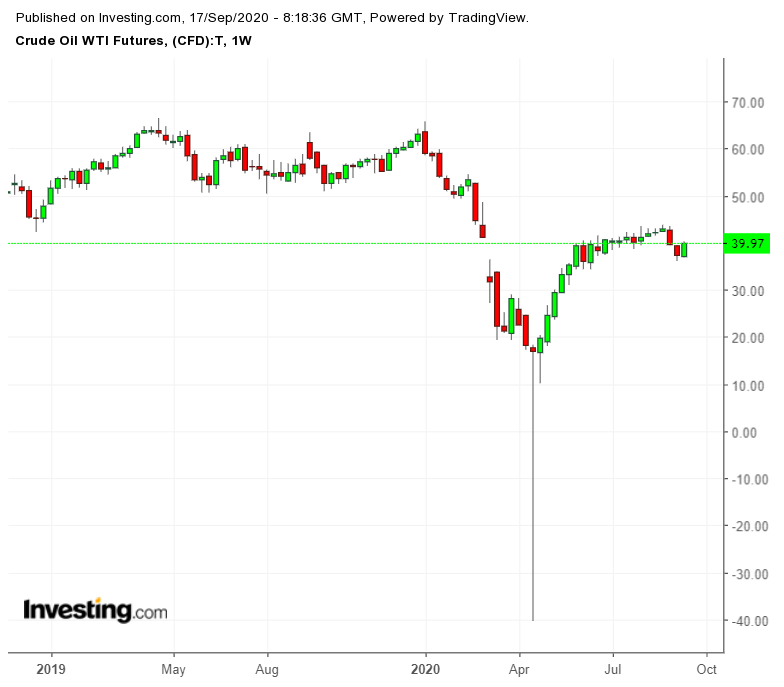The oil market saw several dour forecasts for oil demand this week, yet prices ignored these reports and pushed higher.
We continue to see oil in a relative holding pattern, with both Brent and WTI hovering around $40 per barrel—Brent slightly higher. Big changes will probably only come when we get a better sense of the global economic recovery and whether it has arrived, is approaching, or stalling.

The market is waiting to move on major changes in short term demand. Longer term demand issues remain less compelling, but let’s unpack what emerged this week and preview today’s OPEC+ JMMC meeting to explore their implications for the market.
BP (LON:BP) Demand About-Face
BP (NYSE:BP) released its Energy Outlook 2020 earlier this week and made major headlines by theorizing that global oil demand may have topped in 2019. This is a major departure from BP’s 2019 forecast, which saw peak demand occurring in 2030 (an already aggressive forecast).
The important thing to understand about the scenarios presented in BP’s Energy Outlook 2020—two of which see oil demand never again rising above 100 million bpd—is that they aren’t really forecasts. Rather, this report assumes the desired conclusion of an approaching “energy transition” and then explains how we get there.
Some of the reasoning in the report is suspect. For example, every scenario—even the “business-as-usual” version—assumes that governments will continue increasing their promotion of renewable energy technology at the same rate as they have over recent years.
This may be true if governments commit stimulus funds to energy transition promotion, but it may not happen because of the costs they have already incurred this year. Moreover, if President Trump wins reelection, he and other conservative politicians globally are less likely to spend on energy transition plans.
The BP report is designed to support BP’s strategic plans to shift away from the fossil fuel business entirely—a growing trend among European oil companies. Traders shouldn’t use BP’s projections to inform their considerations of future oil demand, because it isn’t realistic.
The report shouldn’t even be considered alongside the forecasts provided by the IEA, EIA, OPEC and ExxonMobil (NYSE:XOM) because it is primarily useful for investors looking at BP’s future plans and share price, which include spending $5 billion a year on “low-carbon technologies” and transitioning away from fossil fuels, even away from natural gas.
IEA And OPEC's Revised Outlooks
Meanwhile, both the IEA and OPEC revised their 2020 oil demand forecasts lower again. OPEC’s primary reason for cutting its outlook was that it no longer sees demand recovering quite as robustly in India and other Asian countries.
The IEA echoed OPEC’s sentiment that demand in East Asia and India will be weaker-than-expected, but it also sees serious weaknesses in global air travel and jet fuel continuing well into 2021. It expects that global oil demand will only reach 91.7 million bpd and sees oil demand decreasing during the rest of 2020. The market was not scared by these two revisions, indicating that sentiment was probably already more skeptical than either the IEA or OPEC.
Where OPEC and the IEA may be wrong is Asia. We are seeing weaknesses in China’s September oil consumption, but that is likely to prove transitory. As discussed in this column last week, China’s demand looks likely to pick up in the fourth quarter as bottlenecks are resolved and additional storage capacity is built.
We are also seeing preliminary data from GasBuddy and IHS Markit showing that gasoline consumption in the U.S. has decreased since Labor Day, a week and a half ago. It is possible that gasoline consumption could pick up around Thanksgiving (toward the end of November) and the end-of-year holidays, but it is unclear how many people will feel comfortable traveling to see family in 2020.
Oil prices shrugged off all of the depressing forecasts this week. WTI went up by nearly 5% and hit $40 per barrel on Wednesday based on a positive EIA report that showed that U.S. oil stocks decreased last week. Brent also rose to just above $42 per barrel. But neither is moving out of this price range until something real changes with the economy and demand.
Further OPEC+ Production Cuts?
OPEC+ is holding a virtual Joint Ministerial Monitoring Committee (JMMC) meeting today to assess compliance with quotas and possibly give recommendations for changes to oil policy. Some analysts are predicting that the JMMC will recommend further cuts because oil prices are still not rising.
However, Saudi Arabia, a nation that retains a lot of power in the group, does not want to curtail its production any further. While Saudi Arabia’s domestic oil and gas consumption will be dropping as the cooler temperatures arrive, its primary concern in the oil industry is supplying its lucrative East Asian contracts.
Since Saudia Arabia likely understands that China and other nations in Asia will see increased demand, it's unlikely to assent to further production slashes at this time.
